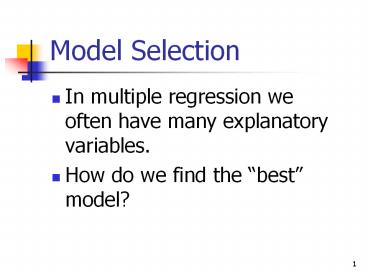Model Selection - PowerPoint PPT Presentation
1 / 27
Title: Model Selection
1
Model Selection
- In multiple regression we often have many
explanatory variables. - How do we find the best model?
2
Model Selection
- How can we select the set of explanatory
variables that will explain the most variation in
the response and have each variable adding
significantly to the model?
3
Cruising Timber
- Response Mean Diameter at Breast Height (MDBH)
of a tree. - Explanatory
- X1 Mean Height of Pines
- X2 Age of Tract times the Number
- of Pines
- X3 Mean Height of Pines divided by
- the Number of Pines
4
Forward Selection
- Begin with no variables in the model.
- At each step check to see if you can add a
variable to the model. - If you can, add the variable.
- If not, stop.
5
Forward Selection Step 1
- Select the variable that has the highest
correlation with the response. - If this correlation is statistically significant,
add the variable to the model.
6
JMP
- Multivariate Methods
- Multivariate
- Put MDBH, X1, X2, and X3 in the Y, Columns box.
7
(No Transcript)
8
Correlation with response
9
Comment
- The explanatory variable X3 has the highest
correlation with the response MDBH. - r 0.8404
- The correlation between X3 and MDBH is
statistically significant. - Signif Prob lt 0.0001, small P-value.
10
Step 1 - Action
- Fit the simple linear regression of MDBH on X3.
- Predicted MDBH 3.896 32.937X3
- R2 0.7063
- RMSE 0.4117
11
SLR of MDBH on X3
- Test of Model Utility
- F 43.2886, P-value lt 0.0001
- Statistical Significance of X3
- t 6.58, P-value lt 0.0001
- Exactly the same as the test for significant
correlation.
12
Can we do better?
- Can we explain more variation in MDBH by adding
one of the other variables to the model with X3? - Will that addition be statistically significant?
13
Forward Selection Step 2
- Which variable should we add, X1 or X2?
- How can we decide?
14
Correlation among explanatory variables
15
Multicollinearity
- Because some explanatory variables are
correlated, they may carry overlapping
information about the response. - You cant rely on the simple correlations between
explanatory and response to tell you which
variable to add.
16
Forward selection Step 2
- Look at partial residual plots.
- Determine statistical significance.
17
Partial Residual Plots
- Look at the residuals from the SLR of Y on X3
plotted against the other variables once the
overlapping information with X3 has been removed.
18
How is this done?
- Fit MDBH versus X3 and obtain residuals Resid(Y
on X3) - Fit X1 versus X3 and obtain residuals - Resid(X1
on X3) - Fit X2 versus X3 and obtain residuals - Resid(X2
on X3)
19
(No Transcript)
20
Correlations
Resid(YonX3) Resid(X1onX3) Resid(X2onX3)
Resid(YonX3) 1.0000 0.5726 0.3636
Resid(X1onX3) 0.5726 1.0000 0.9320
Resid(X2onX3) 0.3636 0.9320 1.000
21
Comment
- The residuals (unexplained variation in the
response) from the SLR of MDBH on X3 have the
highest correlation with X1 once we have adjusted
for the overlapping information with X3.
22
Statistical Significance
- Does X1 add significantly to the model that
already contains X3? - t 2.88, P-value 0.0104
- F 8.29, P-value 0.0104
- Because the P-value is small, X1 adds
significantly to the model with X3.
23
Summary
- Step 1 add X3
- R2 0.706
- Step 2 add X1 to X3
- R2 0.803
- Can we do better?
24
Forward Selection Step 3
- Does X2 add significantly to the model that
already contains X3 and X1? - t 2.79, P-value 0.0131
- F 7.78, P-value 0.0131
- Because the P-value is small, X2 adds
significantly to the model with X3 and X1.
25
Summary
- Step 1 add X3
- R2 0.706
- Step 2 add X1 to X3
- R2 0.803
- Step 3 add X2 to X1 and X3
- R2 0.867
26
Summary
- At each step the variable being added is
statistically significant. - Has the forward selection procedure found the
best model?
27
Best Model?
- The model with all three variables is useful.
- F 34.83, P-value lt 0.0001
- The variable X3 does not add significantly to the
model with just X1 and X2. - t 0.41, P-value 0.6844































